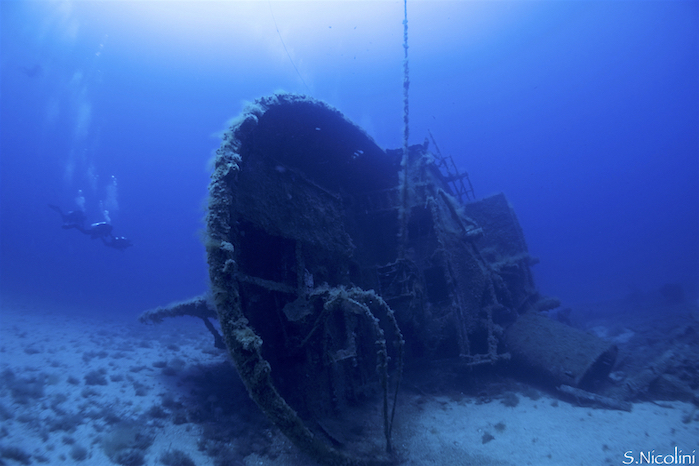- Post author By netcreativity
- 11 April 2022
Anna Bianca Wreck
Type of Dive
- Recreational
- Tech
The Anna Bianca wreck today lies at a depth of between 33 and 52 meters lying on a white sand seabed. The stern part is still well preserved, while the central part of the ship is now completely destroyed. The bow is approximately 52 meters deep.
The wreck is resting on its starboard side, on a sandy seabed about forty meters deep which slopes towards the West to a depth of over fifty meters. The wreck cannot be penetrated as the structures have collapsed and are full of electrical cables and lines. In the captain’s cabin it is easy to spot enormous conger eels and large red scorpion fish.
Among the twisted sheets you can easily come across large codfish and lobsters and entire colonies of shrimp.
The wreck is marked before the dive and the descent takes place on the top of the marker.
Our suggestion is to go up the wall, in order to do a longer dive and enjoy the ascent on the landslide full of life

The ship was originally named Vivien. After the launch it had many changes of ownership and name changes; Fridius, Carlin, Mariù, Tirana and finally bought by an Italian company that renames it Eminia. During the war, Italy desperately needed all the merchant ships possible to be used to supply the troops engaged on the so-called “fourth shore” – Libya. The ship was requisitioned and used by the Regia Marina for the transport of materials and spare parts in the war zone.
In 1943, after the armistice of 8 September, she was sunk by the Germans in the port of Bari, but obviously her story didn’t end there! She decides to recover her, and for the small freighter the carousel of names and changes of ownership begins again: first Vandam, then Argo and finally in 1963 Anna Bianca. And we arrive at the tragic night of April 3, 1971.
According to an island legend, in fact, on the night of the shipwreck the sea was calm and the weather clear. The ship would have been sunk by its crew to pocket the insurance premium, evidently higher than the value of the small boat. Soon after the Anna Bianca was engulfed by the waves the islanders found a large amount of white powder floating around the island. Drug! thought the most, and there are those who tried to recover as much as possible.
However, the reality seems to be less shady. Eyewitnesses say that that spring night there was truly a time for wolves. So much so that the ship, unable to maneuver, hit the rocks and remained at the mercy of the waves for hours, after the crew had managed to get to safety on shore. However, the story of the white powder is authentic, even if what was found floating the morning after the shipwreck, among pieces of wood and other junk, was pumice stone powder!


